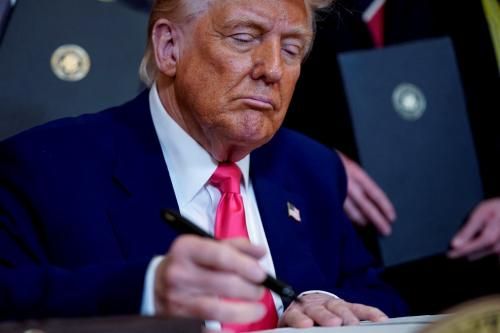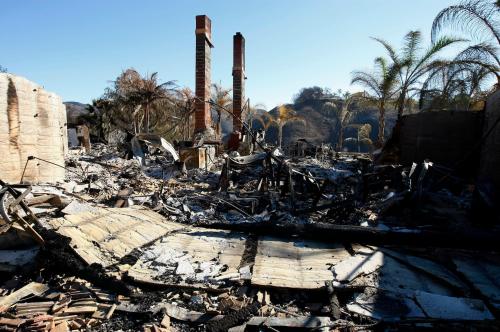Figuring out just how much the President can legitimately accomplish without Congress’s cooperation is all the rage in Washington these days, especially since President Obama’s audacious January declaration: “I’ve got a pen, and I’ve got a phone.” My Brookings colleagues E.J. Dionne, Bill Galston, and Elaine Kamarck each shared their perspectives recently. Meanwhile, House Republicans have declared this to be “Stop Government Abuse Week,” with circumvention of Congress by executive actions being one of their main concerns.
Yesterday the Supreme Court got in on the action, hearing oral arguments in Utility Air Regulatory Group v. EPA (for summaries, see the New York Times and SCOTUSblog), a case with potentially deep implications for the institutional division of power among branches in our modern regulatory state. At issue is what the EPA is to do with a statutory conundrum: as a consequence of regulating greenhouse gas emissions under the Clean Air Act (already contested and decided), a long-standing EPA interpretation would force the agency to regulate carbon dioxide (CO2) emissions by issuing Prevention of Significant Deterioration (PSD) permits for all sources emitting more than 250 tons per year. That threshold serves as a cutoff for major emission sources of other regular pollutants, including power plants and large factories; smaller sources of emissions need not worry about this part of the law.
Unfortunately, CO2 is emitted in much greater volumes than the other regulated pollutants that the law was written to control. When the numerical applicability threshold (which is explicitly set by the statute) is applied to CO2, it would require regulation of many tens of thousands of sources that the act was never intended to cover, which EPA rejected as “absurd.” What appears to be a straightforward application of clear legal text thus causes an administrative and political problem of epic proportions: small emitters from shopping malls to high schools seem to be pulled into an air pollution regime requiring costly compliance efforts. A mismatch of statute and problem causes a big headache.
The agency’s way out is simple and bold: it rejected “250” and replaced it with “100,000,” thereby establishing what it believed was a suitable cutoff for major sources. By EPA’s lights, this “tailoring” of the statute brings it into accord with congressional intent and hews closely to the demands of common sense. Industry petitioners, on the other hand, believe such brazen statutory revision is beyond the executive branch’s powers; they think that the absurdity of the statute suggests that this section of the act ought not to be applied to CO2 at all. (This is a bit of an oversimplification—one problem for the multiple petitioners is a lack of unity and clarity about exactly what should happen.) That would create some interpretive difficulties of its own—but the petitioners say they are making the best they can of possibly ambiguous language, rather than rewriting numbers in the statute that could not be more clear. In the petitioners’ words, for the EPA to “resort to this form of agency self-help” is ultimately impermissible and worrying, as it is not clear what will prevent them from incessantly changing their policy without justification (43).
The importance of this case shouldn’t be exaggerated: it is emphatically not going to determine whether EPA can regulate greenhouse gases under the Clean Air Act, which it can do under other provisions of the law even if it decisively loses here. It’s also possible that if EPA wins, the applicability cutoffs and permitting requirements it determines under the PSD program will be fairly modest, and limited almost exclusively to large emitters of conventional pollutants.
But in other respects the case seems emblematic of a philosophical divide that looms very large in determining the future of our administrative state. As Guido Calabresi described more than three decades ago, “legal obsolescence” is a ubiquitous problem, a natural consequence of having a slow-moving legislature and ambitious expectations for our policies. Old laws touch on new problems, allowing them to be applied; but they are at-best-imperfect matches, and using them entails serious difficulties. Determining who is to resolve these difficulties is thus of great importance.
One might answer: the executive branch is responsible, as it is the best able to take into account the innumerable specifics revealed by implementation and can be generally counted on to be reasonable. Justice Stephen Breyer has been the most forceful advocate of this position, including at yesterday’s argument, where he argued (occasionally in the form of questions) that EPA’s derivation of an implicit exception was appropriate and actually quite unextraordinary. “[O]f course, we do have exceptions when agencies enforce statutes. We do have exceptions from general language all the time,” Breyer argued, later calling such exceptions “the most common thing in law,” and asking, “So what’s the big problem here that everybody seems to have, except me?” (42, 74). Breyer’s M.O. (on full display in his dissent in FDA v. Brown & Williamson Tobacco (2000)) is to say that a law applies and confers power on an agency, but that it is the agency’s responsibility to figure out how to use that power reasonably, even when that requires finding implicit exceptions or diverging from the statutory text’s apparently clear requirements.
Needless to say, some of the Court’s members are far less sanguine about this kind of executive branch adaptation. Justice Antonin Scalia displayed a typically suspicious attitude: “I don’t have as expansive a notion of reading exceptions into a statute that are not there as Justice Breyer does.” He worried especially about whether EPA was trying to “read in exceptions unnecessarily when the absurdity in question doesn’t flow inevitably from the statute, when the statute can be interpreted another way that would not produce the absurdity” (75). For the more textualist members of the court, executive branch agencies can’t adjust statutes too much to current problems—if the law doesn’t fit in important ways, it simply can’t be applied (as the Court decided in Brown & Williamson). Congress is the branch that must be responsible for making adjustments, and if they don’t do so, their lack of action must be respected as meaningfully determining the shape of policy. Breyer’s approach—which practically seems to invite executive agencies to pursue absurdities that then liberate them to act as they sees fit—seems just shy of conferring on the executive branch a prerogative power limited only by its own notion of the public good.
At the heart of this disagreement, then, are questions of institutional competencies: is Congress actually capable of acting as the engine of adaptation? Should executive branch agencies be thought of as developing a common-law-like body of precedents under the statutes they administer, so that the text becomes just one part of the legal fabric? Is the judiciary capable of adequately policing executive branch adaptation, perhaps through use of the Administrative Procedures Act, to ensure that it does not become a vehicle for arbitrary application of state power?
Making American government work requires devising answers to these questions, which are much larger than yesterday’s case. One way to think about them, for which I argue in my article, “When Can You Teach an Old Law New Tricks?” is that the answers might vary from one policy area to another, and courts might well be sensitive to these differences.
Nonetheless, this issue is not going away. It is already heating up in another policy area, health care, as Republicans question President Obama’s authority to delay large sections of the ACA. As they say, to be continued…
The Brookings Institution is committed to quality, independence, and impact.
We are supported by a diverse array of funders. In line with our values and policies, each Brookings publication represents the sole views of its author(s).




Commentary
Greenhouse Gas Regulation at the Supreme Court – The Limits of Executive Adaptation
February 25, 2014